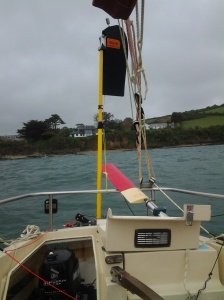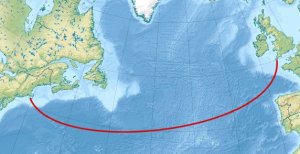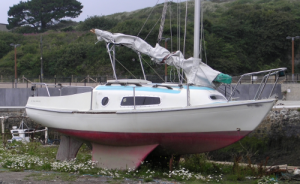The storm had left me without self-steering and with a compromised sail. We approached the entrance to the Fal at night in high winds, rain, and low visibility. Tired after hours on the helm in the storm, I would motor in, anchor till morning, and sort the boat out tomorrow. I switched on the electronic navigation, a great solution on Android tablet from VisitMyHarbour and highly recommended. After a short time the boat appeared on the map with its position, speed, and direction.
The position of the boat could take a while to update. For belt and braces I switched on the depth sounder. It is possible to navigate reasonably well with little more than a depth sounder, the tides, and a good chart. The chart indicates the depth of the water and how it changes. All things being equal near a smooth sandy shore when the depth is increasing the boat is moving away from the land. When the depth is decreasing with a smooth sloping bottom the boat is approaching land. Extend this idea and the depths and contours on the chart are a guide to where the boat is and how it is moving. With poor visibility, I entered the Fal with computer navigation, GPS, and a check using the depth gauge.
Everything seemed fine. I knew the river and where to anchor the boat. Then the electronics started giving silly outputs. The depth gauge said I was in 20+ feet of water but could hear the surf a little closer than felt comfortable. The computer updated and placed the boat onshore and moving inland. Through the mist and rain I could just about make out a line of boats moored ahead. I veered the boat away from the shore and moved parallel with the moored boats. The gale was blowing towards the shore so I let out all 125 feet of anchor chain. That should hold it. My depth gauge had never caused an issue before and was still reporting about 20 feet deep. I could see nothing near the boat but the were few lights, a heavy mist, and spray from the wind.
The sound of waves braking on the shore somewhere nearby was still a little loud for comfort. Updating the computer navigation put me in the shallows. But the depth gauge consistently told me 20 feet. Unfortunately, I trusted the depth gauge more. Nonetheless, I would wake up every 30 minutes through the night to check on the boat. Slowly as the night progressed and visibility improved a short cliff with trees on the top came into view. They seemed a reasonable distance away but the sound of the waves seemed closer. Gradually, a rocky foreshore came into view. It was close – too close for comfort.
The depth gauge kept telling me the water was 20+ feet. Something was wrong here. Still, the boat was secure and safe for the moment. Somehow, I would need to manoeuvre Newlyn Maid out of this predicament and back out to sea. With the strong onshore wind my main concern was that she needed some neat and careful positioning to avoid the obstacles. Close manoeuvring is one thing I can’t do and it makes me feel nervous even at the thought. This felt as scary as being in a harbour.
As daylight arrived I fastened up the loose bolts and screws on the self-steering and checked all the parts. It seemed OK after the storm. Everything on the self-steering that I could see or reach from the safety of the cockpit was checked and rather a lot of the nuts needed tightening. It appeared to be back to working order. The sliding hatch would need reattaching and the gallows for the junk sail was not usable. I would get these repaired in Plymouth. I went forward and retied and tensioned the ropes on the sail. The batten that had come lose was given close attention and the others checked and given extra cord. The boat was ready to sail on and I was giving some thought on how to sail away from the shore.
That Was Unexpected
The self-steering worked when tested briefly in Mounts Bay under engine power and I could use that to keep the boat pointing the right way when lifting the anchor. I set the self-steering to maintain the direction of the boat into the wind. The motor was adjusted to move the boat slowly forward on the anchor, into the wind, and away from the shore. I moved forward and gradually pulled up the anchor chain keeping pace with the boat’s forward movement. My muscles are not really used to such strenuous work and I struggled through the pain but kept up. The boat crept further out into the river as the anchor chain was taken up. Taking in the chain moved her out another 100 feet or more away from the shore.
Feeling the anchor on the bottom meant I had only a few feet of chain to lift. I would pull up the anchor, dash back to the cockpit, disengage the self-steering, and grab the tiller. It would take perhaps 15 seconds in total from starting to take in the anchor, to grabbing the tiller. I had run through the process in my head several times and thought about what might go wrong. Of course, I did not foresee the actual events.
Firstly, the rudder might not bite and steer the boat as she was moving forward slowly. The strong wind might add to this and swing the boat around. However, I only needed to boat to stay in the general direction away from the land. Veering off at right angles or more would be fine. To cause a problem the boat would need to turn almost completely round and do a 180. Even if the boat turned around and headed directly towards the land it should be easy to turn back once I was on the tiller and engine controls. If turning away from the shore did not work then putting the motor into reverse would resolve the issue. Yes, it should work.
The boat did turn round 180 degrees and point towards the land. It was moving slowly and as anticipated not responding to the rudder quickly enough for me to change direction in time. I put the motor into reverse and it sounded as if the engine was breaking up. A loud grinding noise was emitted. I looked at the shore and then back at the engine. The motor was new. It shouldn’t be doing this. It had been running in neutral and moving forward without problem. I seemingly had a choice: risk damaging the engine or be grounded. I chose to risk the motor but the noise just increased and the engine cut out.
Looking down at the motor I saw the self-steering rudder in the water. It had been shaken about in the storm. The loose rudder fell off as soon as it was asked to do any work. As a safety feature the rudder design disengaged and came off if a force was applied. It was tied with a line to the boat so it could not get lost. Unfortunately this meant going in reverse sent it straight into the prop.
I watched the boat drift languidly towards the shore with insufficient speed for the rudder to steer. Grabbing the boat hook I tried to gain time by pushing on the bottom only to break the wooden handle. There was the slight bump and Newlyn Maid was resting on the bottom. To top it all the depth gauge now happily displayed that there was 10 feet of water rather than the inches that the boat hook submerged before hitting the bottom. Looking down I could see a series of flat rocks just below the surface. On balance, I thought the boat hook was more accurate and we were in rather less than 10 feet of water.
I pulled the self-steering rudder back onto the boat looking at it with astonishment. It appeared to have been bitten by a small shark where the propeller had hit. Not only that but even the holding jubilee clips were loose and all the ball bearings were gone. The storm had got to them. These rudder fastenings were difficult to check as they were not fully visible from the cockpit.
A young man asked if I would like to be pulled off the shore and Newlyn Maid was moored up at a nearby buoy. I phoned the shore crew to let them know the self-steering had collapsed, the motor might be damaged, and I would not be at the start of the Jester Challenge. I would meet them the following morning in Mylor marina and we should go to watch the other Jester boats set off.
Perhaps we could make repairs and start late? Ewen the non-organiser of the Jester’s stringently applied non-rules agreed. Of course, the Jester non-rules were clear you could start whenever and finish whenever.
Ewen said I could start from Newlyn after making repairs but he would dock 2 days off my passage time. When he realised I had bought a copy of his book on Blondie Hasler he jokingly said he had changed his mind and I could have the 2 days back.
In the event the spectator boat for start of the Jester was cancelled because of the bad weather. Ewen fired the starting gun with the competitors looking on. The bad weather had continued and the Jester boats delayed their start waiting until it was sensible to leave. It was strange firing a gun to start a race with no-one at the starting line and the competitors watching and cheering. But hey its the Jester – what do you expect?
Tony and I returned to Mylor thinking we could fix and modify the self-steering. We would ask Mousehole Mick to reduce the height of the system so it could be safely set in bad weather. Additionally, we would repair the rudder and tie it securely to the system so it could not come off. Then we would add a control bar and ropes so the direction could be set from inside the cabin. Finally, all the nuts and bolts would be replaced by locking nuts and the critical ones super-glued in position. For background info the plastic parts of the Y&B self-steering had all stood up well in the storm. The system’s use of plastic had often been related to me as potentially weak. There seemed to be no problems with the materials but the system needed to be modified again if it was going to be used in foul weather. We could ruggedise the system and start the Jester late.
However, on releasing the top of the self-steering’s pushrod it disappeared below the water with a plop. Huh? I had been going to tie the top of the pushrod to the boat before releasing it from the drive axle at the bottom. Gremlins were on overtime, the drive axle had gone, lost in the storm. The boat needed some serious TLC and most likely would not be going on the Jester this year.
When we arrived in Plymouth, only 5 boats had made the start of the Jester Challenge out of nearly 50 potential entries. It is folk law that getting to the start of the “race” is far more difficult than taking part. I like to think this is the case as my attempt at starting the Jester was being somewhat less than easy. In the event, only 2 boats Ella Trout 3rd (Roger Fitzgerald in a Dehler 29) and Independence 2nd of Charlsian (Paul Mead in a She 31) actually completed the journey to Newport. The Jester is well named – a challenge.
Two more boats nearly made it across the Atlantic but turned back through bad weather and equipment failure. Notably, Basil Panakis in his boat Jaba (Contest 25) turned back because of an irreparable self-steering failure amongst other equipment failures in mid-Atlantic. Fortunately, Newlyn Maid’s self-steering problems occurred in bad weather on the way to the start rather than in the middle of the ocean. But it didn’t feel lucky at the time.
I waited a few days for the weather to calm and had a gentle sail back around the Lizard to Newlyn. Before leaving, I asked a local boat builder to check the main rudder. There was a slight play in the tiller and I didn’t want yet another equipment problem and particularly not with the main rudder.
On the way back I set up the standby bungy-cord self steering and tried it out. In the moderate sea it worked fine I could even go below for a minute without going too far off course. I sailed around Mounts Bay for several hours waiting for the tide and Tony and Jo to come down to help put the boat on the pontoons in Newlyn harbour. Sailing around the bay in reasonable weather I wondered if everything would have been different if the sea trials and setting up the boat in St Ives bay had not been derailed by the local lifeboat. Que Sera Sera.
My really bizarre experience was about to start when sailing Newlyn Maid back around Lands End.









